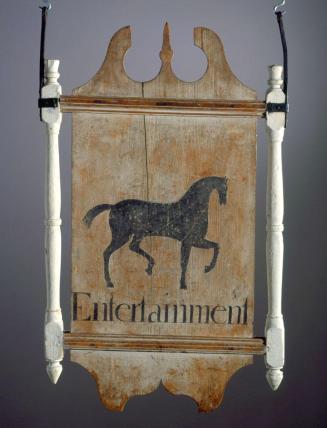Sign for Bull's Inn
Original OwnerOriginally owned by
Captain Edward Bull
(American, 1717 - 1782)
MakerMade by
Unknown
Date1749
MediumPaint on pine board, oak frame, iron hardware
DimensionsPrimary Dimensions (height x width including hardware): 49 1/4 x 31 3/4in. (125.1 x 80.6cm)
Other (height x width of sign only): 48 1/2 x 31 3/4in. (123.2 x 80.6cm)
ClassificationsPainting
Credit LineCollection of Morgan B. Brainard. Gift of Mrs. Morgan B. Brainard
Object number1961.63.9
DescriptionImages: On both sides, profile of riderless black horse, on white ground. The horses are centered on the board and identical in profile, but they face in opposite directions on each side. There are no underlying images.
Text: On both sides, on pediment, "EB."; under image, "ENTERTAINMENT./ FOR MAN &. HORS"; on apron, "1749". Side 2 differs in having reversed numeral "7". There is no underlying text.
Construction: Single board, with single molded, horizontal rails, and turned posts. Board is set vertically and hand-sawn at top and bottom to create decorative pediment and skirt profiles; board passes through full-width mortice cut through each rail and is held by nails. Each rail is tenoned through the turned posts with two parallel tenons and secured at each joint by two pins.
Text: On both sides, on pediment, "EB."; under image, "ENTERTAINMENT./ FOR MAN &. HORS"; on apron, "1749". Side 2 differs in having reversed numeral "7". There is no underlying text.
Construction: Single board, with single molded, horizontal rails, and turned posts. Board is set vertically and hand-sawn at top and bottom to create decorative pediment and skirt profiles; board passes through full-width mortice cut through each rail and is held by nails. Each rail is tenoned through the turned posts with two parallel tenons and secured at each joint by two pins.
Collections
Label TextThis is the earliest American tavern sign known to have survived without repainting. The image of the black horse and the words “ENTERTAINMENT. / FOR MAN &. HORS[E]” are among the most common on 18th-century tavern signs. Especially in this early period, before improved roads made coach travel practical, travelers on horse-back depended on finding overnight accommodations with stables and food for their mounts as well as lodging and meals for themselves.
NotesHistorical Note: Original location. Bull's inn is said by family tradition to have been at the intersection of what is now Rt. 153 and Ingham Hill Road in the Centerbrook village of the town of Essex. This site seems rather inconveniently distant from the eighteenth-century highway. Perhaps this was a later residence, occupied by Bull after his retirement from tavernkeeping in the 1760s. Bull also owned properties in the center district of Centerbrook, a more likely site for an inn.Maker Note: The specific maker of the sign is unknown, but was probably a Saybrook sign painter who was active from about 1749 to 1771.
Technique Note: Surface notes. This sign displays only one paint layer on each side; side 2 is more weathered. The horses are identical in outline, suggesting use of a template, which was reversed from one side to the other. Lettering appears to have been executed by hand within guidelines scribed into the board. Both images and lettering, painted black, are raised above the lead-white ground, which has largely worn away. Rails and posts may have been painted gray.
Status
On viewCaptain Aaron Bissell Sr.
1772-1786
1820-1838













